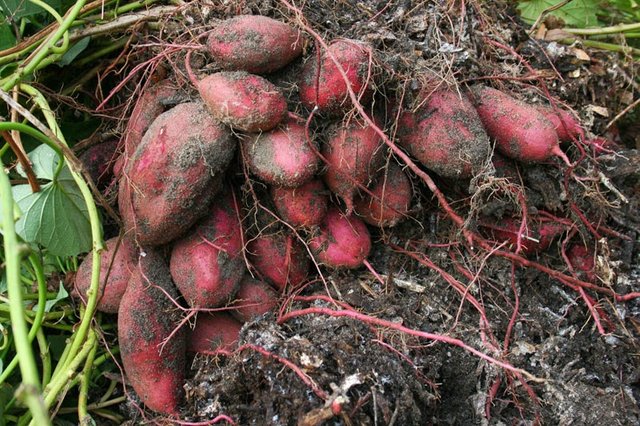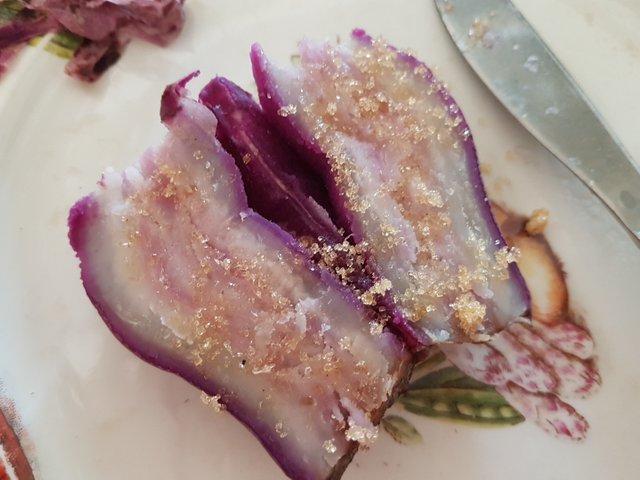Planning To Grow Sweet Potatoes

Sweet potatoes are very nutritious and one of my favorite crops, definitely above regular potatoes. This was a reply to @crescendoofpeace article on Red Amaryllis - Day 247. It has been improved for posting as an article here. Hopefully, this will encourage people considering growing sweet potatoes or struggling with them.
I’ve been growing sweet potatoes for a couple of years and have developed a method that works best for me. Last season would have been great if not for the voles that ate most of them before I could. Will be putting out a bunch of snap traps with peanut butter on gauze in the patch very soon to knock them down before spring. When spring first arrives, some of the things will be deployed that @crescendoofpeace suggested in her replies to discourage their presence.
The secret to sweet potatoes is remembering they're tropical tubers and can't go in the ground before the soil temp reaches 60°F. Make sure the variety you choose is appropriate for your growing season length. Another consideration might be how much vine the variety produces which could consume more space. Also, don’t use store bought sweet potatoes which may have had a sprouting inhibitor applied. My favorite is Japanese Red (shown above) which have red/purple skin and light yellow to white flesh. They’re soooo sweet that all we put on them is butter. They can be cooked any way you prefer.
The plants are best started from “slips” which are the little sprouts that grow from a sweet potato. The slips sprout better warm at about 80 to 85°F in a sunny window. About 1 April here in NE Oklahoma (zone 7a), I start my slips on a heat mat using the old 3 toothpicks and a quart mason jar method. The starts should be good specimens as large as will fit in the wide-mouth jars with the toothpicks around the tuber about half way down. The heat mat is placed on a few thicknesses of cardboard to reduce heat loss into whatever it’s sitting on. An insulating wrap is put around the group of jars and tissue stuffed in the spaces between the jars to hold in as much heat as possible. It’s important to keep an eye on the water level and top it off frequently with non-treated water (I collect a lot of rain water from the roof gutter down spouts and use that). The water will go bad quicker than you expect, so be sure to keep it changed out often enough.
After a slip is about 8 to 10 inches long, I break or cut it off as close to the mother tuber as possible. The removed slips are laid in a large glass casserole, or plastic flat pan at least 2 inches deep, almost full of water at a comfortable indoor temperature above 65F (no heat mat) by a south facing window with only the top few leaves out of the water. Soon a bunch of roots will start all along the submerged portion of the slip. Make sure the water stays above the roots and doesn't go bad in the pan.
I tried buying slips the first year and they weren’t ready until later than optimum for planting. Also, they get seriously stressed by the handling and shipping. Its far better to grow your own so they’re very healthy when they go in the ground and you have them as soon as its time to put them in the ground. More time in the ground means more bigger sweet potatoes.
Planting entire sweet potatoes was also attempted, but they tend to rot which spreads to the rest of the connected roots.
After you get a lot of roots established on the slips, at least 1 to 2 inches long, the slips are ready to go in the ground, if the soil is at least 60°F (I use a compost thermometer to check this). If it’s still too cool they can be left in the pan and the roots allowed to grow longer. If you run short of space, they can be stored with the same conditions as the pan in 2-quart wide-mouth mason jars, or glass vases at least 9 inches tall, with the roots kept under water which is maintained as with the pan.
Sweet potatoes like very loose or sandy well drained soil and work great in my deep mulch (Back To Eden) garden which allows me to dig nearly all of them up with my gloved hands alone. Like most root crops, you should not give them a bunch of nitrogen which makes a lot of leaves and not as much root. The slips can be planted about a foot apart. I like to make holes through the compost down to soil level about 2-feet apart. Then four slips are planted equally spaced around the inside of the hole at ground level, extending horizontal away from the hole’s center, at the soil/mulch interface. A long trowel is used to make a horizontal hole, raise the mulch above the soil and allow the slip to be poked in under it until about 3-5 leaves are showing. Put a stake in the middle of each hole so you’ll know where the plants started after the vines obscure the locations. Water well after planting then make sure the soil doesn't dry out and, on the other hand, isn't soggy for a long time.
The best part while waiting for fall harvest is that sweet potato leaves are tasty, nutritious and very plentiful. They're great raw when snacking in the garden or on salads and also cooked like you would spinach or chard.
Leave the roots in the ground until the soil temp drops to 60°F and definitely not below 55°F. Then it’s time to dig them up carefully, following the roots, and trying not to damage the skin any more than necessary. If you have chickens, they will appreciate eating all the foliage. Let the sweet potatoes sit out to air dry a few days and then gently brush off the loose dirt (don't wash) so as not to damage the skin.
Some people cure them for 7-10 days at about 85°F with 90% humidity to heal any damage before storing, but I don’t have a good way to do that and they seem to do fine. The damaged ones can be eaten first, or ground up and frozen to cook like hash browns.
Store with good ventilation around the tubers in stacked but separated single layers, in a dark closet, at about 60-65°F (a little warmer is probably okay, but definitely not below 55°F). They keep really well like this. Some say the humidity should be kept high, but without condensation, during storage. However, not adding to the humidity has worked well for me. Any light may cause them to start sprouting slips prematurely. Save the best sweet potatoes that will fit in a wide-mouth jar to make slips the next year.
It’s time to start finding good sweet potatoes to make slips from in much of the northern hemisphere. If you make a lot of extra slips, you can get other people started growing sweet potatoes too. Happy gardening.
Thanks for sharing! I'm writing a post for tomorrow that features sweet potatoes along with 10 other vegetables that can be grown as perennial greens. The leaves of a lot of varieties of sweet potatoes can be harvested and eaten as a cooked green.
In my area (zone 8) there are sweet potatoes that will overwinter and come back each year. I'm planning on growing some as a perennial root/greens crop.
I am in Wales in the UK. My climate can't be too far off yours in Washington. What is the variety of the overwintering sweet potatoes? I would love to try those in the UK.
Editor of the The State of Steem SoS Daily News.
Promoter of The State of Steem SoS Weekly Forums.
Editor of the weekly listing of steem radio shows, podcasts & social broadcasts.
Founder of the A Dollar A Day charitable giving project.
Thanks for the resteem. Hope my post helps. Up here in NE Oklahoma sweet potatoes often overwinter, but you can't count on it after a bad winter. Also, I think there are less problems with root rot after starting with a new slip in the spring. Look forward to seeing your article.
Congratulations, your post has been selected to be included in my weekly Sustainability Curation Digest for the Minnow Support Project.
Editor of the The State of Steem SoS Daily News.
Promoter of The State of Steem SoS Weekly Forums.
Editor of the weekly listing of steem radio shows, podcasts & social broadcasts.
Founder of the A Dollar A Day charitable giving project.
Many thanks
Congratulations @ppmsilver! You have completed the following achievement on the Steem blockchain and have been rewarded with new badge(s) :
Click here to view your Board
If you no longer want to receive notifications, reply to this comment with the word
STOPTo support your work, I also upvoted your post!
This is a really nice article @ppmsilver. My partner was talking just today about wanting to start sweet potatoes. We had some for dinner, and like you said.. delicious. I appreciate the tips about the slips and waiting for the roots to be 2 inches long. It is very helpful to know details as we understand the basic concept but have never grown slips before. Is constant heat source a must? What do you think about keeping it near the wood stove which is on part of the day and off part of the day?
Keeping slips near the wood stove is a fall back method I haven't depended on yet. The slips form too slowly at 70F and I don't know if temperature variation from 70 to 80F would have the same effect. You definitely don't want the temperature to drop below 60F. Warmer than 80F to maybe 90F is likely not a problem for this heat loving plant. Too near the wood stove could be a problem. I use those 10x20 inch heat mats that go under pans full of tomato and pepper starts that like it warm. The heat from the sun shining on them probably helps too and might be contained with a clear enclosure. Glad you liked the article
Thanks for your thoughts on this :) We are on solar and the heating mats draw a lot from the batteries as I experienced last year with starting peppers and tomatoes, hence why I am brainstorming creative solutions!
Maybe a clear enclosure in the sun of a window to heat up in the day. The water in the jars will act as a heat sink. You could add some bricks in there for more thermal mass to hold the heat longer, and maybe add warmed bricks as needed at night. Could cover it with an insulating blanket at night to keep the heat in. Just thinking out loud... Making sure the enclosure doesn't get to hot inside will be important. Posed a private question regarding shop setup earlier on discord. Cheers.
We have such an amazing diversity of sweet potatoes here in Northern Thailand - the subtropical climate is \perfect for them. Love them any which way but simply roasted and served with herb butter would have to be my favourite. Feeling the itch to get out in the garden. :)
Funny enough, we plant them for their leafy vegetables, not the rootcrops. Which we should as we keep buying 1 or 2 pieces when we feel like cookin a dish. As for the steamed, bbq or chips, we buy the raw ones.

Have you tried the purple ones?